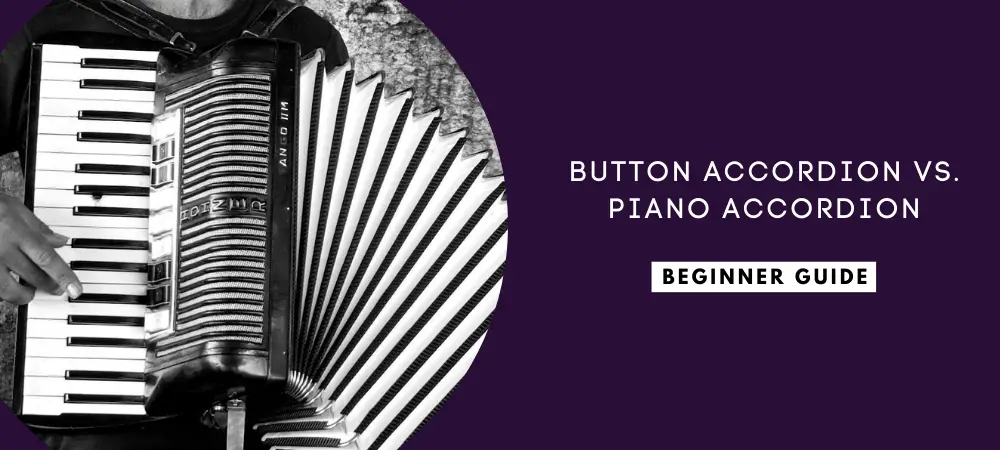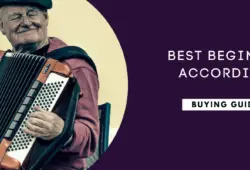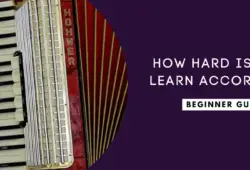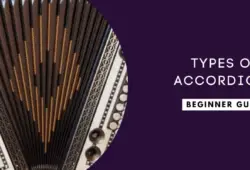The debate about the best type of accordion has been going on for long. While some players prefer the modern piano accordion, others will go for the button accordion, anytime.
But, I also realized that the answers are given mainly depending on the type of instrument best suitable for individual performers.
If you want to learn the major differences between the two, you’re reading the correct article.
We are about to give you an in-depth analysis of these two instruments to help you make a better choice. Are you ready to learn? Let’s get started!
Table of Contents
Differences Between the Button Accordion vs Piano Accordion
History: The origins of button accordion and piano accordion
The History of the first Diatonic button accordion takes us back to 1829, where it was primarily labeled as the “Accordion,” by Cyril Demian.
It’s believed that it’s within the same year that Charles Wheatstone invented the first concertina.
The Diatonic button instrument enjoyed sole fame, until around 1850, when the very first chromatic accordion came to be, after being invented by Franz Walther.
But where does the name “accordion” originate from?
It’s believed that this name was derived from the German word “Akkord,” commonly used to refer to the significant triad that plays whenever the player sounds the bass buttons.
Another assumption is that the accordion emerged from the upgrading of the various reed instruments, which were rampant in Southeast Asia.
The mass-production of the button accordion is said to have taken place around 1835. And even at that time, the instrument produced loud sounds, was durable and portable.
It, however, wasn’t cheap, the reason as to why primarily elites could own it.
The good news is that things changed after the invention of the piano accordion, and around the 1860s, the cost of the button accordion was lowered and spread to other social groups.
In the beginning, these button instruments were only used to play chords and only in a left-Handed manner.
At that time, they only had five buttons and made great accompaniments in various musical performances.
The button accordions were famous in France, Belgium, Scandinavia, and other previous Soviet countries.
On the other hand, the history of the piano accordion takes us back to around 1852, when it’s believed to have been invented by Bouton of Paris.
But that’s not all. Other historians claim that the first account wasn’t accurate, and the first piano accordion came to live in 1854, after being showcased by Mattaus Bauer in Munich.
The Piano instrument’s use quickly spread, giving its button counterpart stiff competition.
In 1871, Nikolay Ivanovich Beloborodov built the first chromatic piano accordion in Russia, and the popularity of use continued to spread.
It, however, wasn’t until the 1900s that the first piano accordion reached America. And because of its ease of us, it rapidly gained fame to be ranked among the top instruments in North-America around 1972.
The instrument spread to other English-speaking countries, and then Italy, Australia, New Zealand, and South Africa.
Hardware Differences
The Piano accordion, as its name suggests, comes with a piano-like keyboard on its right-hand.
The keys to this instrument provide a soft touch. They are also small and quickly move inwards towards the bellows, making it easy for performers to use one hand, as the other holds the accordion.
One type of piano accordion is the bass piano instrument, with a lower octave. They usually don’t have base buttons.
The primary advantage of using the Piano accordion is its simple layout. Also, this instrument shares a lot of similarity with other keyboard devices.
Its range is, however, a little smaller, and it can be problematic for small players to reach all the notes due to its large size.
Therefore, with the piano accordion, players have to finger each key differently, which is work!
Back to the bass piano accordions, they usually comprise of a right-handed keyboard, which uses reeds in sizes of 32’, 16’ and 8’. This instrument uses the deepest pitch on pedal C as its lowest note.
Here’s a video on the different types of piano accordions:
On the other hand, the button accordion, as the name suggests, is an accordion-type characterized by buttons on its melody-side keyboard.
During performances, this instrument produces sounds as the air hits the reeds.
The construction of these instruments vary, and so does the keyboard system.
The diatonic button accordion, for example, is usually bisonoric, meaning a press on a single button instantly affects the note sounds as the bellows contract or expand.
So, technically, you can compare its mechanism as that of the harmonica.
There is also the chromatic button accordion, which is closely related to the piano accordion.
It, however, allows players to use 3-5 rows of buttons on the right-hand. Therefore, as you can see, this is unisoronic, meaning the note-sound consistency remains no matter how the bellow is pulled or pushed.
This makes fingering easy, and so learning the button accordion isn’t difficult.
When to use the Piano Accordion?
The Piano accordion must be ranked among the most popular for a reason, right?
First, it’s because most individuals have, at one point, tried playing the standard piano instrument or are at least familiar with its functionality.
Therefore, if this sounds like you, you’re likely to find the piano accordion’s keys pretty easy to pick and play, even at the first trial.
You see, these instruments use the same keyboard as the piano, which is strategically positioned on the right-hand side.
However, young players find it challenging to reach far-placed keys. So, it would be best if you wait until you receive some sort of training (self/tutor-led) before your first session.
Professional players find this instrument easy to handle, of course, due to their experience and age because of the more cumbersome size.
Besides, the instruments come with numerous buttons, which can easily confuse learners.
If you would love to learn how to play modern jazz, then you should be ready to use the piano accordion as it’s famously used in such performances. The same case applies to all other types of complex sounds.
Another fact, commonly unknown to beginners, guitar players usually find it easy to pick the piano accordion. This should also apply to anyone with a history with the various brass instruments.
Therefore, before you purchase this instrument, learn to question yourself genuinely. Like for example, how familiar am I with other devices? Or what kind of music will I enjoy playing?
Remember, it’s essential to love what you’re doing as nothing beats the resilience that comes with passion, especially when learning something new.
And since the piano instrument is usually more massive than the button accordion, you should figure out how you will be transporting it.
Do you have a private car? Is there anyone who will help you carry it whenever there is a need? Or is your physical strength enough to hold the weight even when you have to move from place to place?
When to use the Button Accordion?
As already mentioned earlier, the button accordion came first before the piano accordion. It mainly uses the bisonoric system, where players have to use only one or two keys.
And because of the fewer number of buttons, it’s pretty easy for beginners to pick.
The most popular type of the button accordion is the diatonic button accordion, which has only 7 notes, complete with 2 notes.
Therefore, the instrument is also suitable for lively folk performers and generally lovers of traditional music.
Also, because of its lighter weight and small size, this kind of instrument isn’t anything close to the piano accordion. It, therefore, can be comfortably played by younger performers, learners, and non-professionals.
However, one major downside is that it’s quite challenging to memorize this instrument, so you should take it up only if you’re willing to spare more training time.
And although I have said that it’s easy to play, mastering the different buttons isn’t as quick as some might think. You should be patient.
But, even with this said and done, sometimes it boils down to personal preferences. Some individuals prefer one instrument over the other, and no matter the odds, nothing can stand between them and their dream of becoming good.
Bottom Line
Therefore, even after reading this article, you should go ahead and do your thing if you hold the same opinion you had. You might end-up surprising everyone, especially yourself, at what you can achieve.
Ooh, before I forget, the piano accordion tends to be more versatile than the button instrument. This is primarily because its right-hand techniques easily translate to other musical instruments.
So now you know which side to look when versatility is all that counts.
Check out this video on the Playing Scales – Chromatic versus Piano:
Last words
Button accordion vs. Piano accordion? So many differences between the two. Not only from a historical perspective but also their structure and sound production.
Most individuals with past piano/guitar experience will find it easier to finger the piano accordion. And on the other hand, with the button accordion, it’s easy to pick, even without any prior musical experience.
Therefore, we hope this insight helps you make the best choice.




